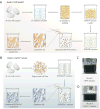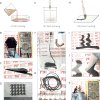Integration of stiff graphene and tough silk for the design and fabrication of versatile electronic materials
- PMID: 30505261
- PMCID: PMC6261468
- DOI: 10.1002/adfm.201705291
Integration of stiff graphene and tough silk for the design and fabrication of versatile electronic materials
Abstract
The production of structural and functional materials with enhanced mechanical properties through the integration of soft and hard components is a common approach to Nature's materials design. However, directly mimicking these optimized design routes in the lab for practical applications remains challenging. For example, graphene and silk are two materials with complementary mechanical properties that feature ultrahigh stiffness and toughness, respectively. Yet no simple and controllable approach has been developed to homogeneously integrate these two components into functional composites, mainly due to the hydrophobicity and chemical inertness of the graphene. In this study, well-dispersed and highly stable graphene/silk fibroin (SF) suspension systems were developed, which are suitable for processing to fabricate polymorphic materials, such as films, fibers, and coatings. The obtained graphene/SF nanocomposites maintain the electronic advantages of graphene, and they also allow tailorable mechanical performance to form including ultrahigh stretchable (with a strain to failure to 611±85%), or high strength (339 MPa) and high stiffness (7.4 GPa) material systems. More remarkably, the electrical resistances of these graphene/SF materials are sensitive to material deformation, body movement, as well as humidity and chemical environmental changes. These unique features promise their utility as wearable sensors, smart textiles, intelligent skins, and human-machine interfaces.
Keywords: Graphene; electronic materials; processing; silk.
Figures





References
-
- Chen H, Müller MB, Gilmore KJ, Wallace GG, Li D. Adv Mater. 2008;20:3557.
-
- Novoselov KS, Falko VI, Colombo L, Gellert PR, Schwab MG, Kim K. Nature. 2012;490:192. - PubMed
-
- Potts JR, Dreyer DR, Bielawski CW, Ruoff RS. Polymer. 2011;52:5.
-
- Zhang Y, Gong S, Zhang Q, Ming P, Wan S, Peng J, Jiang L, Cheng Q. Chem Soc Rev. 2016;45:2378. - PubMed
-
- Ling S, Li C, Adamcik J, Wang S, Shao Z, Chen X, Mezzenga R. ACS Macro Lett. 2014;3:146. - PubMed
Grants and funding
LinkOut - more resources
Full Text Sources
Other Literature Sources
Miscellaneous
